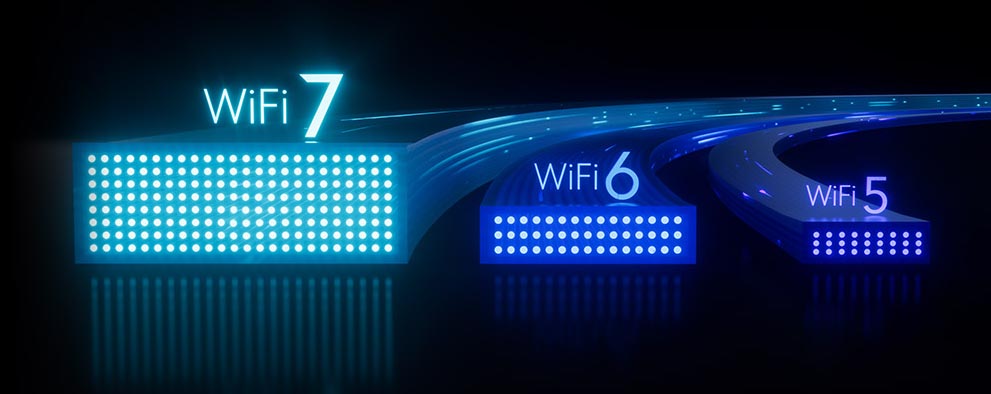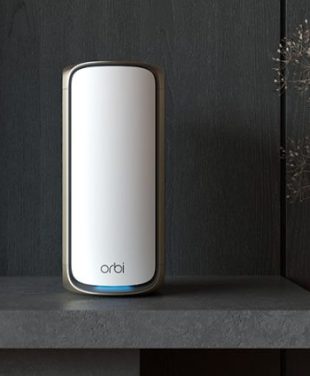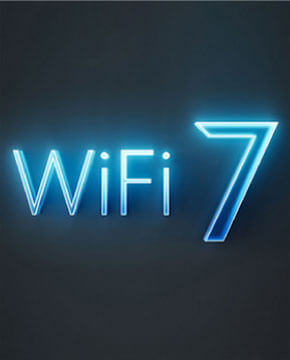The world of WiFi has continually evolved since being introduced to consumers in 1997 – both in terms of speed and capability. The initial WiFi offering was based on the IEEE 802.11 standard, and subsequent standards such as IEEE 802.11b or IEEE 802.11g were named based on their updates and amendments to capabilities. In 2018, the WiFi Alliance made the naming of WiFi standards easier to understand and adopt. Now, we are being introduced to the next amazing phase, called WiFi 7, and understanding how we got here will help us appreciate all that WiFi 7 has to offer.
IN THIS ARTICLE
The Journey of WiFi to WiFi 7
WiFi technology has become all pervasive in the way we live and work in our connected world. The WiFi industry takes advantage of existing and new technologies such as direct-sequence spread spectrum (DSSS) and orthogonal frequency division multiplexing (OFDM), along with other refined enhancements to create fast, stable, and reliable wireless technology for mobile devices and whole home networks today and into the future.
802.11b and the 2.4GHz frequency band
WiFi took the world by storm when it was first introduced, with consumers and businesses realising the benefits of increased Internet connectivity and capability. In the late 1990s, 802.11b was released. Using a 2.4GHz frequency, 802.11b supported a maximum theoretical rate of 11 Mbps with a range of 150 feet. Additionally, the components of 802.11b were inexpensive – making the technology more accessible. However, it also had the slowest maximum speed, and since 802.11b operated in the 2.4GHz band, competing devices and other 2.4GHz WiFi networks could cause interference.
802.11a and the 5GHz frequency band
With 802.11a, also introduced in the late 1990s, a more complex technique known as orthogonal frequency division multiplexing (OFDM) was used to generate the wireless signal, giving it a few advantages over 802.11b. It operated in the less crowded 5GHz frequency band, making it less prone to interference, and its bandwidth was much higher with a theoretical max of 54 Mbps. Given these advantages, it was more expensive and found more in business applications while 802.11b was more popular in the consumer market.
Introducing 802.11g
The next improvement came with 802.11g. Using the same OFDM technology as the 802.11a, the 802.11g supported a maximum theoretical rate of 54 Mbps. However, like the 802.11b, it operated in the more crowded 2.4GHz frequency and was still prone to interference issues. On the plus side, it was backward compatible with 802.11b devices, allowing some 802.11g users to enjoy significantly faster WiFi speeds and coverage for a wide range of devices.
Then came 802.11n – WiFi 4
The next significant breakthrough came in 2009 with 802.11n or what we now call WiFi 4. WiFi became faster and more reliable, as 802.11n supported a maximum theoretical transfer rate of 300 Mbps (and could reach up to 450 Mbps when using three antennae). 802.11n used Multiple Input Multiple Output (MIMO). This means there were multiple transmitters and receivers that could operate simultaneously at one or both ends of the link, providing a significant increase in data without needing a higher bandwidth or transmitting power. Additionally, it could operate in both the 2.4GHz and 5GHz bands.
The next big step – 802.11ac or WiFi 5
Representing a big step in the evolution of WiFi, 802.11ac or WiFi 5 was introduced in 2014. This standard offered supercharged WiFi speeds from 433 Mbps all the way to several Gigabits per second. 802.11ac worked exclusively in the 5GHz band, supported up to eight special streams, doubled the channel width to 80 MHz, and used a technology called beamforming, where radio signals can be directed toward a specific device.
Another important advancement with WiFi 5 was multi-user MIMO (MU-MIMO). While MIMO directs multiple streams to a single client, MU-MIMO can simultaneously direct the spatial streams to multiple devices. Although this doesn’t increase the speed of any single client, it can increase the overall data throughput of the entire network.
802.11ax – WiFi 6
The introduction of WiFi 6 propelled the industry even further. WiFi 6 avoids traffic congestion in public spaces, offers higher data rates and capacity (up to 9.6 Gbps), and has improvements similar to 5G. It also offered better 2.4GHz and 5GHz spectrum support and increased multi-user, multiple input, multiple output (MU-MIMO) from 4 x 4 to 8 x 8. The overall result is better and faster performance, allowing a person to connect even more devices in their home. And, unlike past standards, WiFi 6 allows one router to handle more antennas and connect to more devices.
WiFi 6E and the 6GHz frequency band
WiFi 6 is still a contemporary favourite, but time marches on, and WiFi 6E soon arrived to again shake up the industry. With WiFi 6E, you get all the benefits of WiFi 6 plus an all-new 6GHz frequency band with higher throughputs and lower latency. The 6GHz band is exclusive to 6E devices. 6GHz also boasts a super high-speed connection with up to 10.8 Gbps WiFi. This new form of WiFi also offers users less interference with 3X more high-bandwidth 160MHz WiFi channels.
The new WiFi 6E technology enables 4K/8K streaming, AR/VR gaming, and HD video conferencing. Naturally, WiFi leader NETGEAR was showing the way with the industry’s first quad-band WiFi 6E system. The Orbi Mesh WiFi 6E system ensures maximum throughput with 16 separate WiFi streams. The result is a better user experience, more seamless gaming and so much more. Check out the Nighthawk Tri-Band WiFi 6E Router & Orbi Quad-band WiFi 6E Mesh System for inspiration.

The future has arrived - WiFi 7
Previously, multi-gigabit internet plans were outpacing the existing WiFi 5 technology. WiFi 7, also known as IEEE 802.11be, introduced in September 2023, is the industry response. Dubbed EHT for Extremely High Throughput, WiFi 7 makes futuristic multi-gigabit WiFi a reality with faster speeds and less interference for today’s numerous high-bandwidth requirements.

WiFi 7 is a quantum leap forward, even compared to WiFi 6 and WiFi 6E. Even better, WiFi 6E is supported by WiFi 7, meaning the latest technologically advanced wireless devices such as iPhone 15 Pro and Pro Max smartphones will seamlessly sync with the WiFi 7 platform. So, what does this all mean for the end user and wireless communication? Let’s take a look.
Faster speeds
WiFi 7 is much faster than WiFi 6. The 2.4x faster WiFi connection speeds equate to maximum speeds on a typical cell phone of around 5Gbps. WiFi 7 ensures your home is ready for 10 gigabit wireless access performance.
Greater channel width
Current WiFi 6 routers and WiFi networks operate in smaller bands of 20/40/80/160MHz for connecting to individual devices. WiFi 7 doubles the bandwidth to 320MHz, effectively doubling WiFi speeds and adding a lot more bandwidth.
More data density
WiFi 7 increases the amount of data that can be encoded onto a radio signal compared to earlier WiFi 4, WiFi 5, and WiFi 6 systems. This is measured by quadrature amplitude modulation (QAM). Where WiFi 6’s QAM limit was 1024, WiFi 7 offers an impressive 4096 (also known as 4K QAM), boosting its peak rates to increase throughput. The result is a 2.4x improvement in WiFi speeds between WiFi 6 and WiFi 7.
WiFi 7 in Action - The NETGEAR Orbi 970
The Orbi 970 Series Quad-Band WiFi 7 Mesh System unlocks the extraordinary power of WiFi 7 for your whole home wireless LAN (WLAN) system. Supported by the WiFi Alliance and the Federal Communications Commission, WiFi 7 delivers unprecedented WiFi speeds of up to 27Gbps from the main access point to every corner of your wireless local area network – from the front door to the back gardenand the basement to the rooftop.

This whole-home high-performance system can deliver up to 10 gigabit speeds for a future-proofed system, plus quad-band technology that can support up to 200 devices concurrently. Here is a recap of some amazing features exclusive to NETGEAR Orbi and WiFi 7.
- From 8K streaming to video conferencing, gaming, VR, and more, Orbi ensures your family can accomplish it all at once, without sacrificing speed.
- Exclusive quad-band technology with dedicated backhaul ensures your WiFi stays fast across all your devices simultaneously.
- Newly designed high-performance antennas provide exceptional 360° MU-MIMO WiFi coverage for every corner of your home.
- 10Gbps & 2.5Gbps Ethernet ports unlock unbeatable speed and reliability for wired connections – including gigabit-hungry gaming consoles and media devices.
- Orbi 970 works with any internet service provider. The Orbi app makes it a breeze to set up and manage your WiFi across all your laptops, client devices, gadgets, and smart home IoT appliances.
- NETGEAR Armor WPA3 software provides an automatic shield of security for your WiFi and connected devices.
The Orbi 970 whole home mesh system introduces users to never-before-seen Gbps internet speeds for all connected devices. Seamless wireless network functionality is a reality with WiFi 7, making the Orbi 970 the go-to WiFi networking solution for every occasion. This new standard supports 80MHz channels without fuss.
WiFi 7 is the most progressive WiFi standard yet. For blazing-fast data rates and next-level WiFi, NETGEAR Orbi WiFi 7 is the answer we have been waiting for since internet WiFi was introduced way back in the 1990s.
From Hedy Lamarr’s frequency hopping invention to the WiFi 7 that we enjoy today, we can truly see how far the field of telecommunications has evolved.





